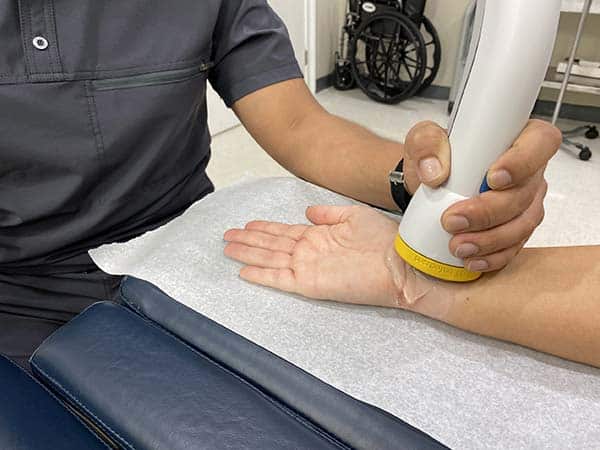
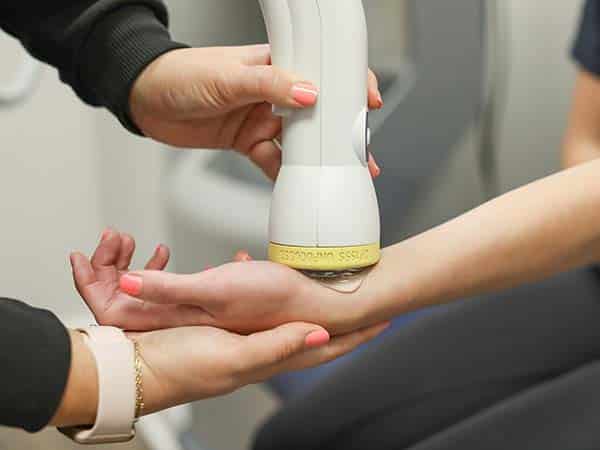
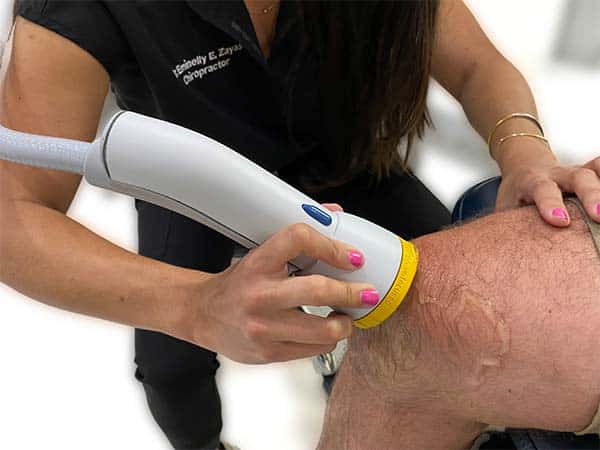
From serious sports injuries causing tissue damage to bone issues and stiffness that comes with age, living with pain is, well, a pain. But it's more than that - it's a stressful, often upsetting way to get through your day, month, and year. Have you ever tried to get out of bed with sore, stiff knees? Most folks would rather just get back in bed. Think you might try exercising with plantar fasciitis? Don't plan on running far or doing cardio for very long. Torn rotator cuff? Without proper treatment, your life might not ever be the same.
Living with pain and the inevitable issues that come with age can seriously affect your wellbeing and happiness. Sure, you could wake up every morning and rely on addicting medications to help you move. Or, you could risk further injury and damage with invasive surgeries that require long periods of recovery and downtime. But those can't be the only two options for treatment, can they?
Fortunately, a new, natural, non-invasive treatment for pain is revolutionizing the medical industry and transforming people's lives. It's giving athletes, average folks, and people of a certain age a reason to be hopeful. It's called Softwave therapy, and unlike many fly-by-night medications and sketchy treatments, it's backed by science and provided by Elite Healthcare Physical Medicine.
If you're barely making it through the day suffering from chronic pain, this FDA-approved drug-free treatment may be for you. Softwave therapy has already been used by thousands of people around the country living with issues like shoulder pain, knee pain, and plantar fasciitis. You could be next.
Though its popularity has only grown in recent years, Softwave therapy - also known as shockwave therapy - has been around for years. In fact, the first systematic study into the benefits of shockwave therapy took place way back in 1950. So, what is Softwave therapy?
Softwave therapy is a method of treatment that works incredibly well for mobility rehab, pain relief, and full-body recovery, usually from chronic pain or injuries. Softwave therapy uses a device emitting low-energy soundwaves that target a patient's injured area. These low-intensity waves boost blood flow and kickstart your body's natural healing processes, relieving long-term pain and helping your body to heal a wide range of injuries and conditions.
The main targets in the body include bones, tendons, and other soft tissues, which are encouraged to regenerate and repair via the shockwaves. Often, shockwave therapy is used in conjunction with other non-invasive treatments like chiropractic care, which we offer at Elite Healthcare Physical Medicine. The results are often incredible, leaving patients wondering why they never tried Softwave therapy before.
Softwave therapy works especially well for:

Better Blood Flow

Collagen Stimulation

Reducing Inflammation

Kickstarting cell growth and healing factors

Breaking down build-ups of calcium
With FDA clearance, little-to-no side effects, and quick application time, Softwave therapy is a welcome alternative for people suffering from pain. Who wants to spend weeks or months recovering from a surgery that might not even work? Likewise, who would want to become dependent on over-the-counter or, even worse, prescription pain meds? Living a life of addiction is a road nobody wants to go down.
Softwave therapy represents a revolution in non-invasive pain treatment; best of all, it's highly effective. Independent studies prove that shockwave therapy helps with pain. 65-91% of patients using shockwave therapy experienced real-deal improvements in damaged muscle and bone tissue, solving their mobility problems and drastically reducing pain. It almost sounds too good to be true, but as many patients at Elite Healthcare Physical Medicine will tell you - it isn't.
Book AppointmentSome of the most common conditions that Softwave therapy treats include:



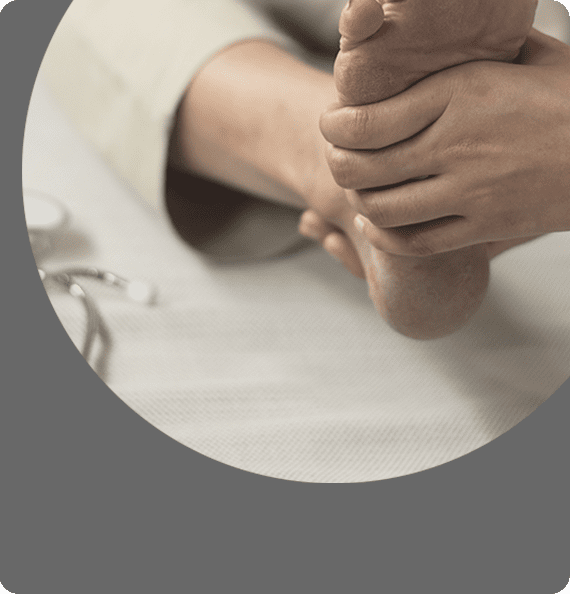

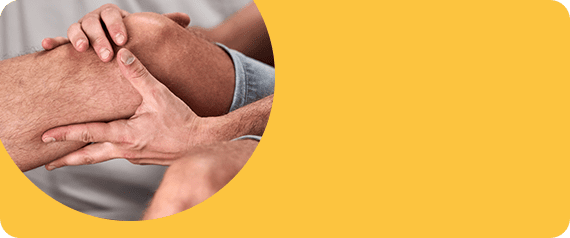


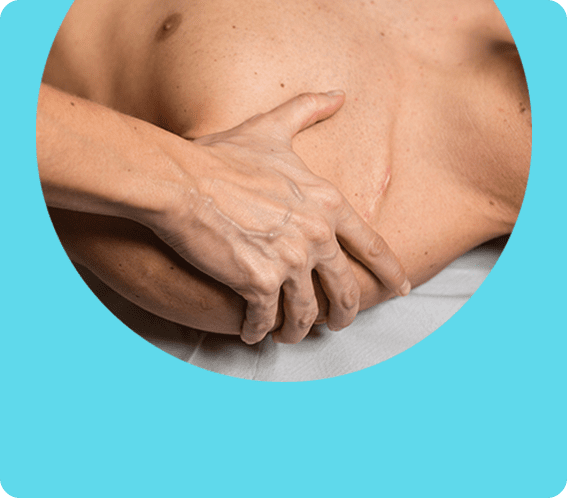
When you get up in the morning and go to the bathroom to brush your teeth, do you notice a stabbing, sharp pain near your heel? Does the pain go away once you have a chance to walk around? If so, you could have plantar fasciitis. According to the American College of Foot and Ankle Surgeons, this painful condition is quite common. About two million people suffer from plantar fasciitis every year, and almost 10% of all people will experience the condition at least once in their life.
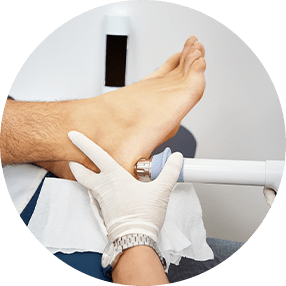
This common foot issue happens when the plantar fascia - a fan-shaped tissue near your heel - gets inflamed. The plantar fascia is a thick strip of connective tissue that links your toes to your heel bone, helping to preserve the arch of your foot. When this band is strained, it causes intensely sharp pain, usually in the morning when you wake up and plant your feet on the floor.
Most folks ignore plantar fasciitis because the pain eventually goes away throughout the day. However, if left untreated, plantar fasciitis can lead to weakness and chronic pain, which may affect daily walking.
Some causes of plantar fasciitis include:
The short answer to this question is not really. Patients with plantar fasciitis will ice the affected area with little-to-no relief since they spend so much time on their feet. It's hard to rest an achy heel if you've got a job that requires you to be on your feet. Anti-inflammatory meds like Advil don't work all that well, either. They may provide temporary pain relief, but in terms of a long-term solution, taking these drugs will cause major side effects.
Book AppointmentWhen more conservative treatment options like ice and over-the-counter meds don't work, most doctors turn to ultra-expensive orthotics, steroid injections, or invasive surgery. For the average person, those options fail on all fronts, as they carry risks for side effects and may even cause the issue to worsen.
Instead of going under the knife or changing their daily routines, many people suffering from plantar fasciitis are turning to Softwave therapy for relief.
During a shockwave therapy session, our expert providers use a special probe to deliver pressure waves to inflamed tissue. These waves trigger natural healing processes causing new blood vessels to form. In turn, oxygen is supplied to the affected area, reducing inflammation and causing healthy cells to regenerate. Shockwave therapy also produces collagen, which is crucial for connective tissue health.
With just a few visits, many patients find long-term relief from plantar fasciitis without relying on strange drugs or harmful surgeries.
Living with knee pain is just miserable. From knee tendonitis to osteoarthritis, knee pain can prevent you from enjoying activities and affect your day-to-day life. Your knee is a joint comprised of cartilage, bone, ligaments, and fluids. Tendons and muscles within the knee help the joint move. When one of these crucial knee structures is hurt or compromised, it results in knee pain and long-lasting knee problems. This, in turn, leads to difficulty walking at best and debilitating knee issues at worse.
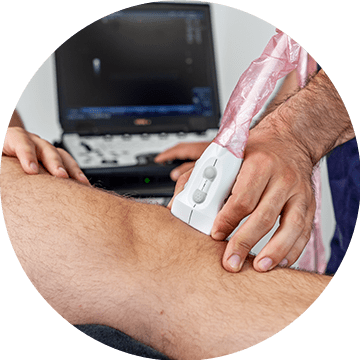

If you're an active person or somebody who plays sports often, you're probably all too familiar with knee pain - especially common conditions like patellar tendinopathy. Also called "jumpers knee," this issue happens at the patellar tendon, which is found on the front of the knee just under the knee cap. When living with this condition, most patients experience pain around the kneecap or lower down on the leg around the tibia.
In addition to injuries and issues like jumper's knee, everyday wear and tear will cause knee pain over time. With time, this knee pain can develop into arthritis. If your knees are swollen, painful, or stiff, you may have arthritis in your knees. Regardless of the kind of knee pain you're experiencing, treatment options have been limited to agonizing surgeries and addicting pain medications. But that all changes with shockwave therapy for knee pain in McClellanville, SC.

Though no two knee pain problems are exactly the same, shockwave therapy has been shown to be highly effective for knee pain. In fact, many patients at Elite Healthcare Physical Medicine find relief after just one session. Many times, sessions can be completed in as little as 30 minutes. So if you want to find relief for knee pain on your lunch break, that's definitely possible.
As is the case with plantar fasciitis, Softwave therapy works by sending sound wave and low-energy impulses to the affected area of your knee. These pulses stimulate your body's healing factors, which can help regenerate and repair damaged tendons and tissues. Softwave therapy for knee pain is especially promising for people who have tried other treatments - like surgery and pain meds - with disappointing results.
Benefits include:
Several studies and reviews prove that Softwave therapy can be very beneficial for people suffering from knee pain problems like jumper's knee. A study involving 66 patients with knee pain found that they enjoyed a significant improvement in their reported pain levels with Softwave therapy. In fact, knee pain was reduced by nearly 50% after a single month. When combined with other regenerative and physical therapy treatments at Elite Healthcare Physical Medicine, your days of living with knee pain are numbered.
Book AppointmentHere's a fact for you to consider: Every joint that you have in your body plays a part in your day-to-day life. But when we think of joint issues, we typically jump to knee issues. However, your knees aren't the only joints in your body to go through wear and tear. Your shoulders experience just as much, if not more, wear and tear than your knees. We put a strain on our shoulders just about every time we use or move our arms. Our shoulders play a pivotal part in living a normal life. When they begin to deteriorate over time due to age or overuse, it creates a litany of painful problems.
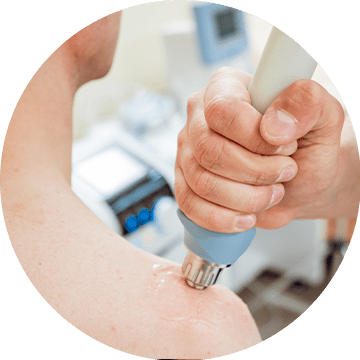

There are many causes of shoulder pain, like deterioration, inflammation, and trauma. Of the many painful shoulder conditions affecting Americans yearly, rotator cuff tendonitis and arthritis are very common. Also called calcific tendinitis, rotator cuff pain is caused by built-up calcium deposits on the shoulder's tendons, which connect your rotator cuff to nearby muscles and bones. This painful condition is usually linked to sports, like basketball and volleyball, or in professions requiring repetitive movements, like in the plumbing industry.
Some common symptoms of shoulder pain and rotator cuff tendinitis include:
Though strengthening exercises and some medications provide temporary relief for shoulder pain, they're not meant as long-term solutions. Luckily, Softwave therapy for rotator cuff pain in McClellanville, SC, can help.
Shockwave therapy has been shown to work wonders for shoulder pain. Low-intensity shockwaves break up calcium deposits and jumpstart your body's healing processes, stimulating blood flow and healthy cell growth. Shockwave treatment is especially effective for long-term shoulder pain since it releases stem cells, sends growth factors to the affected area, and boosts capillary production. Shockwave therapy has also been shown to break down scar tissue and eliminate trigger points, all of which decrease shoulder pain. This relief is most often long-lasting, unlike other treatments like medications and injections.
Many studies support the efficacy of Softwave therapy for shoulder conditions like rotator cuff pain and calcific tendonitis of the shoulder. In a study of 84 patients living with long-term rotator cuff tendonitis, participants in the treatment group saw a significant decrease in the intensity of their shoulder pain. Another study related to shockwave therapy for calcific tendonitis found that 86.6% of patients experienced fewer calcifications.
If you're having to live with rotator cuff pain or another type of shoulder issue, choosing Softwave therapy may be your best course of action.
Book AppointmentWhether you're sick of living with intense heel pain from plantar fasciitis, the mobility issues associated with knee pain, or the day-to-day struggles of rotator cuff degeneration, you'll find hope at Elite Healthcare Physical Medicine. Unlike some medical clinics, our team of doctors and specialists focus on an integrative, multidisciplinary approach to healing. Instead of relying on addictive medications and invasive surgeries, we prefer to address the underlying causes that our patients face.
We combine several all-natural pain relief therapies so that your shoulder pain, knee pain, joint pain, and foot pain go away for good. We resolve pain by using healing treatments that restore function and improve mobility for the long term. Our state-of-the-art regenerative medicine treatments, used hand-in-hand with proven chiropractic techniques, will stimulate your body's healing power from within. If your pain is related to muscles, nerves, and bones, our doctors can help you overcome discomfort, injury, or medical conditions affecting these systems.
If you've been unable to resolve your pain or have become dependent on painkillers to cope, Softwave therapy may be the natural solution you need. It all starts with a quick call to our office, so we can begin to understand your needs. When you come for your first visit, our doctors will find the personalized treatment you need so that you can manage your pain in a non-invasive and drug-free environment manner.
Book AppointmentMCCLELLANVILLE, SC (WCIV) — UPDATE (12/19/23) - The SCDOT confirmed the bridge has been repaired.One resident sent photos of SCDOT crews working on the road Monday night.Nearly 100 people were trapped Monday after the bridge on the only road into a McClellanville neighborhood collapsed during Sunday's Nor'easter storm.The pedestrian bridge on Old Cemetery Road is currently the only way in and out of the Silver Hill neighborhood after its one road in and out collapsed Sunday due to the historic high tide and heavy r...
MCCLELLANVILLE, SC (WCIV) — UPDATE (12/19/23) - The SCDOT confirmed the bridge has been repaired.
One resident sent photos of SCDOT crews working on the road Monday night.
Nearly 100 people were trapped Monday after the bridge on the only road into a McClellanville neighborhood collapsed during Sunday's Nor'easter storm.
The pedestrian bridge on Old Cemetery Road is currently the only way in and out of the Silver Hill neighborhood after its one road in and out collapsed Sunday due to the historic high tide and heavy rain the storm brought.
To keep the holiday season afloat, one local church is stepping in to help.
People are typically swamped preparing for the holiday season, but this year, some neighbors in McClellanville are seeing an overflow of water instead of packages.
READ MORE: Edisto Beach feels impact of Sunday Nor'easter
"I've never seen rain like that before," Seacoast Church member Joanna McClellan said.
Seacoast Church in McClellanville has become a hub for deliveries since the usual front door drop off is no longer available due to the road collapsing.
"A few of the town members have set up UPS to come here and deliver the packages this morning. We just want to be here for the town and the community. Bottom line," McClellan said.
But the trip to seacoast isn't easy for some.
"The bridge we usually drive over is a normal, small, two-lane bridge that we rely on everyday, and we don't think about it too much," Bryan Jones, who lives in the neighborhood, said.
READ MORE: Residents evacuated after 12+ inches of rainfall in Georgetown County
"I've never seen so much water, but I had no idea it would be bad enough to take the whole road out," Bobby Wilson, another resident, said.
People who live in the community say they are thankful, as this bridge was also underwater during the storm.
"Living on the water is great but it has its perils. Here we are kind of living on an island," Wilson said.
"The tide was going out, but there was so much rain the water was still rising," Patrick Klim said while kayaking.
READ MORE: VIDEO: Charleston Co. ambulance out of service after Nor'easter, no impact on EMS services
The South Carolina Department of Transportation is assessing the damage, and as of Monday evening, there is no timeline for when the road will be fully restored.
In the meantime, residents have found new ways to get around.
"I've got some friends in here who are trapped but a couple of them have four wheel drive and have been able to sneak out different ways," Klim said.
Silver Hill residents say they are just happy everyone is safe, and thankful that Santa uses a sleigh to get around instead of a car.
READ MORE: USS Yorktown shifts due to Nor'easter storm, Patriots Point Museum temporarily closes
"Merry Christmas everyone," Wilson said.
CHARLESTON COUNTY, S.C. (WCSC) - The debate between the people of McClellanville and nearby organizations continues as a developer pushes to bring a sand mine to the rural community.The land at Lofton Road off Highway 17 is empty for now. It sits about 900 feet across from Lofton Road from St. James Santee Elementary and Middle. In 2023, the community mobilized and opposed a special allowance for a sand mine through petitions and public hearings.“So the BZA, the board of zoning appeals, they denied Blessing Investment the...
CHARLESTON COUNTY, S.C. (WCSC) - The debate between the people of McClellanville and nearby organizations continues as a developer pushes to bring a sand mine to the rural community.
The land at Lofton Road off Highway 17 is empty for now. It sits about 900 feet across from Lofton Road from St. James Santee Elementary and Middle. In 2023, the community mobilized and opposed a special allowance for a sand mine through petitions and public hearings.
“So the BZA, the board of zoning appeals, they denied Blessing Investment their special exemption requests to establish a mine at the Lofton Road site. They didn’t like that decision. And so they appealed that,” Riley Egger with the Coastal Conservation League says.
Blessing Investment is now suing the board over its denial. The Coastal Conservation League and Friends of Coastal South Carolina applied to intervene in the legal case, to continue advocating against the mine. Their intervention was granted, and they will be at the table for the next mediation meeting.
“We’re really happy that we can intervene and be part of this case and reaffirm the decision from the BZA because they made the right call here and really speak up for the McClellanville area,” Egger says.
The concerns about the mine are its impact on the nearby school and wildlife.
“It’s primarily rural and mines are disruptive. There’s going to be trucks coming in constantly throughout the day, and it’s only 900 feet from St. James Santee Elementary Middle School. That’s not appropriate. The community was clear,” Egger says.
Grace Gasper, Executive Director at Friends of Coastal SC says in her conversations with neighbors in McClellanville, they are all in agreement.
“The area and the impacts need to be considered and our main concern over this one is the proximity of the school and the property also adjoins designated Wilderness Area, Little Wambaw Samp Wilderness and the Francis Marion National Forests,” Gasper says.
Gasper and Egger say once a wildlife area is disrupted, it’s changed forever and unable to be perfectly restored.
“The potential ecological impacts to an area that’s designated to be kept pristine and unimpacted by humans, you know, is unknown at this point,” Gasper says.
Gasper highlights again that it’s not just about wildlife habitat, but also the nearby school.
“We’re really concerned about the disruption to the kids during the school day. What that will do to their use of their outside facilities, and also the safety concern that the dump truck traffic having to make U-turns to enter the site on 17 would cause and they would actually have to either use the road that the school traffic uses,” Gasper says.
Charleston County is already home to more than 30 sand mines according to DHEC’s records.
“There are going to be areas where there’s sand and dirt mining and we’re not unilaterally opposed to that. We think the environmental impacts need to be more closely considered, and that’s, you know, honestly a statewide issue,” Gasper says.
Egger agrees, saying the organization is looking into mines across the state level to gauge the current situation.
“The Lofton Mine is a prime example of where mines shouldn’t exist. And there needs to be a broader reform at the state level so that these don’t happen again,” Egger says.
Copyright 2024 WCSC. All rights reserved.
MCCLELLANVILLE, S.C. (WCSC) - A bridge in McClellanville washed out amid Sunday’s heavy rains leaving around 100 people isolated, officials said.The Charleston County Sheriff’s Office said they were assisting the state’s department of transportation in the Silver Hill community after a bridge on Old Cemetery Road washed out.Rain totals in McClellanville topped 16 inches during Sunday’s storm.Chief Shaun Gadsden with the Charleston County Department of Public Safety says crews responded to the coll...
MCCLELLANVILLE, S.C. (WCSC) - A bridge in McClellanville washed out amid Sunday’s heavy rains leaving around 100 people isolated, officials said.
The Charleston County Sheriff’s Office said they were assisting the state’s department of transportation in the Silver Hill community after a bridge on Old Cemetery Road washed out.
Rain totals in McClellanville topped 16 inches during Sunday’s storm.
Chief Shaun Gadsden with the Charleston County Department of Public Safety says crews responded to the collapse around 9:30 Sunday night. He says they contacted the county’s emergency management division and the State Department of Transportation, who showed up immediately, so they could identify the problem.
Gadsden adds that at least 500 cars pass by Old Cemetery Road per day, which is causing many neighbors in the area to completely re-evaluate.
One of these neighbors is Bobby Wilson, who says he and his wife were supposed to leave for a two-and-a-half-week vacation Monday morning. Now, he says they’re mainly worried about getting their mail, trying to get to work and especially what would happen if one of them were to need medical assistance.
However, they are trying to keep positive.
“Hey, look on the bright side of things,” Wilson said. “It’s Christmas and nobody’s been hurt. So, it’s all good. I hope DOT comes to our rescue sooner than later so we can get out of here.”
Other residents say they had to call off work, couldn’t go to school or had to cancel doctor’s appointments because the only way they can leave is by foot. There is a pedestrian bridge right behind this road that folks say is the only thing keeping them from becoming an island.
“McClellanville is very resilient,” neighbor Bryan Jones said. “We’re a very strong community. There’s always people on the other side of the bridge who are more than willing to help us out... If we had an emergency, they would be more than willing to give us a car or lend us a ride to town. You know, we feel confident and comfortable in that. We’re happy and thankful that we still have water and power and internet.”
Silver Hill residents are not the only ones shocked from the storm. The Town of McClellanville’s mayor, Rutledge Leland, says this storm was hopefully something they will never experience again.
Leland says he thought it was going to be 3 to 4 inches of rain and maybe 40 miles an hour winds, and this just was completely unexpected. He says the town will be providing the funds to create an alternate route and although he did not have a price estimate, he doesn’t think it will be too bad.
“It shouldn’t be a major expense,” Leland said. “Basically, it will amount to putting in some gravel and clearing a little bit of ground up. Making it to be where it is safe to be able to drive. It won’t be a great road, but it will be an access.”
Leland says SCDOT told him it could be about two weeks for the road to be fully repaired.
“That’s the minimum,” Leland said. “They have to wait two weeks before they can start considering to reopen. That’s kind of an old regulation. I’m not sure what it’s based on. We know we’re out for two weeks.”
The South Carolina Department of Transportation sent this statement around 3:45 p.m. on Monday:
SCDOT is working closely with Charleston County and the Town of McClellanville to create temporary access to the Silver Hill neighborhood following a washout at the bridge on Old Cemetery Road in McClellanville. The bridge and approaches are currently being inspected and SCDOT is developing an expedited repair plan to restore the roadway and bridge. Temporary access is expected to be completed and available later today.
Details on the repair timeline will be provided as they become available and we encourage community members to stay tuned to their local broadcasts and the SCDOT website for updates.
Copyright 2023 WCSC. All rights reserved.
South Carolina’s fishing past and present are alive in a few places along the coast of the Palmetto State. And while much of the commercial fishing industry may be shrinking, these quiet and quaint fishing towns in South Carolina seem frozen in time. It’s a perfect place to spend a day – immersed in these little-changed fishing towns remaining in the state. And who doesn’t love visiting the many quaint and charming ...
South Carolina’s fishing past and present are alive in a few places along the coast of the Palmetto State. And while much of the commercial fishing industry may be shrinking, these quiet and quaint fishing towns in South Carolina seem frozen in time. It’s a perfect place to spend a day – immersed in these little-changed fishing towns remaining in the state. And who doesn’t love visiting the many quaint and charming South Carolina small towns?
To be clear, there are several bonafide fishing towns along the coast, but these three are especially amazing because they’ve retained the charm of days gone by and managed to set aside space for visitors to enjoy their nostalgic appeal.
The three towns are only an hour and a half apart so we’ve created a mini road trip and mapped them out for you in a handy Google Maps link. Plan your day correctly and you could have breakfast, lunch, and dinner in different charming little old-timey fishing towns along the South Carolina coast! Have fun!
Advertisement
Advertisement
You'll Never Look At Donuts The Same Way After Trying The Donut Guy In South Carolina
Escape To The Countryside When You Stay At This Rural Airbnb In South Carolina
3 Waterfront Retreats In South Carolina That Are Perfect For Warm Weather Adventures
Advertisement
Fall is the perfect time for this Lowcountry road trip to see three old fishing towns along the coast, although any time of the year will do. Have you visited any of these before? We’d love to know if you’ve ever been to all three on the same day and what are some of your other favorite South Carolina small towns!
If you plan on taking this or any other South Carolina road trip anytime soon, make sure you take a look at our Ultimate Road Trip Essentials Packing List before you hit the road.
Get the latest on things to see, do, and eat around South Carolina!
Melissa M. | December 14, 2023
What are some of the most charming small towns in South Carolina?
Just about every part of the state offers quaint towns that are worth exploring. Here are some of the most charming small towns in South Carolina worth visiting:
Check out more charming small towns in South Carolina.
What are some of the best seafood restaurants in South Carolina? With its coastal fishing villages, it may come as no surprise that South Carolina offers numerous restaurants that serve up some of the freshest seafood. Here are a few:
Check out these must-visit seafood restaurants in South Carolina.
CHARLESTON, S.C. (WCIV) — Plans are finally in motion to replace the old Lincoln High School with a brand new school in McClellanville.It's been nearly a decade since Lincoln High closed. At a board meeting Wednesday night, there was finally talk of what a new school would bring the community.Charleston County School District leaders presented a slideshow detailing the future of the new high school and middle school in northern Charleston County.Since the closure of Lincoln High School, kids are waking up earlier t...
CHARLESTON, S.C. (WCIV) — Plans are finally in motion to replace the old Lincoln High School with a brand new school in McClellanville.
It's been nearly a decade since Lincoln High closed. At a board meeting Wednesday night, there was finally talk of what a new school would bring the community.
Charleston County School District leaders presented a slideshow detailing the future of the new high school and middle school in northern Charleston County.
Since the closure of Lincoln High School, kids are waking up earlier to make the bell at Wando High and returning home late because of the long drive.
The constituent school board said a new school will bring relief to the people living in Awendaw and it will provide help to the schools already reaching capacity.
The district is looking at attendance lines within the area while looking at creating a magnet program.
"I do believe a partial magnet or magnet program of some kind might be within the programming options and given that it's going to have a size of 1,000 students it will probably need to pull in some areas other than just the McClellanville and Awendaw area," said Pamela Jouan-Goldman, Chair of the District 2 Constituent School Board.
Scenarios of possible zoning were shown during the meeting.
The methodology was based off the fiscal year 2022 data.
Parents voiced their concerns of drawing the line further down into Mount Pleasant.
"You do not want to force a family who is living right next door to a school go up the road to another school if at all possible so that's why were looking at the magnet as an opportunity to attract families that want to go there despite any increase in distance then they would have," Chief Operating Officer of CCSD Jeff Borowy said.
The district's goal is to get 500 students in both the middle and high school.
Thomas Colleton, Chair of the District 1 Constituent Board, said the school will need to offer something enticing.
“It is important to this build the school but at the same time let's figure out what were going to be doing inside. The curriculum means a lot," Colleton said.
“I don't know how much it would make sense to drive by Wando High School to get on (Highway) 17 to go up to Awendaw, but it does sound like they are going to have different specific programs at their school. So for example if they have got a great art program and my daughter is really into art, that sounds like a nice option to have," said Jonathan Mars, a parent of students at Carolina Park.
Colleton said it's crucial everyone is transparent throughout this process.
Their next steps will be to develop a blue-ribbon committee to review these options and create a draft to be presented to the constituent boards in October.
"I'm hopeful this blue ribbon commission will ease some of this tension, and let people know going to another school, which would be a state of the art school, why wouldn't you want your child to go there," Colleton said.
The Kaiser Farm Tract property was leased in December of 2021 to the former owner to be used as a hay farm.
The three-year lease agreement is able to be terminated at any time with a 90-day notice.
It's also possible a park and library could be built on the property in the future.
